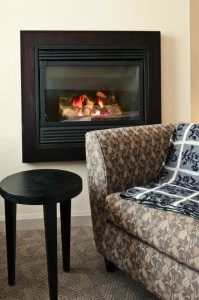 Understanding the type of fireplace you have in your home before lighting a fire is crucial to your health and safety. For example, burning wood in a fireplace designed for gas fuel only could result in an explosion of the gas line. Using vented gas logs in a vent free fireplace will fill the house with toxic carbon monoxide gas. Not all of the potential fireplace mix ups have such hazardous outcomes, but knowing the type you have and how to operate it correctly can make differences like reducing fuel costs and improving indoor air quality.
Understanding the type of fireplace you have in your home before lighting a fire is crucial to your health and safety. For example, burning wood in a fireplace designed for gas fuel only could result in an explosion of the gas line. Using vented gas logs in a vent free fireplace will fill the house with toxic carbon monoxide gas. Not all of the potential fireplace mix ups have such hazardous outcomes, but knowing the type you have and how to operate it correctly can make differences like reducing fuel costs and improving indoor air quality.
One main determination you must make is whether the fireplace is masonry or factory built. Most people imagine masonry fireplaces to have a grand stone or brick hearth with an equally impressive chimney outside. However, factory built fireplaces can still have beautiful stone hearths and even brick covered chimneys. A good way to differentiate between the two is by checking to see if there is a separate insert in the firebox. Factory built fireplaces are inserts that were built off site and are installed as one unit. The interior usually contains angled refractory panels that look like fake brick upon close inspection and have a round damper between 8 and 15 inches in diameter. On the other hand, masonry fireplaces do not have an insert, but rather the firebox is constructed of some type of masonry material. The damper is usually oval or rectangular in shape and is rarely smaller than 8 by 14 inches.
The next aspect to examine is what type of fuel the fireplace runs on. Wood burning fireplaces always have a flue and chimney to vent the toxic gas produced by the fire. Gas burning fireplaces sometimes have flues and sometimes do not, depending on the venting system. However, a gas fireplace always has a gas line running into it. Often the igniter is off to the side of the fireplace and requires a special key.
Finally, decide the venting system used by the fireplace. Masonry fireplaces utilize vented systems, generally, but factory built fireplaces can vary. They can function similarly to a masonry fireplace, with a traditional vertical chimney that expels all the harmful gases and most of the heat produced. These fireplaces can use wood or gas fuel. Another possibility is a direct vent fireplace. In this case, the fireplace is permanently sealed off from the house by glass, which prevents toxic gases from entering the house. Instead, the gases vent outside directly behind the fireplace, meaning there is no need for a tall vertical chimney. Direct vent fireplaces only burn gas fuel. A third possibility is a vent free fireplace, in which no chimney or is necessary. To use these fireplaces safely, only the gas log set designed for use with the fireplace should be used. Burning wood, vented gas logs or even different brands of vent free gas logs in this type of fireplace can dangerously lower air quality.
If you are still unsure of the type of fireplace you have or even if you think you know, it is always wise to have a chimney specialist out to look at the set up. He or she can confidently determine what type of fireplace you have and instruct you on its proper use. For further information, contact Tri County Hearth and Patio Center.